1. Granerod J, Ambrose HE, Davies NW, Clewley JP, Walsh AL, Morgan D, et al. Causes of encephalitis and differences in their clinical presentations in England: a multicentre, population-based prospective study. Lancet Infect Dis. 2010; 10(12):835–844. PMID:
20952256.
2. Lee HG, William T, Menon J, Ralph AP, Ooi EE, Hou Y, et al. Tuberculous meningitis is a major cause of mortality and morbidity in adults with central nervous system infections in Kota Kinabalu, Sabah, Malaysia: an observational study. BMC Infect Dis. 2016; 16(1):296. PMID:
27306100.
3. Kim SH. Diagnosis and treatment of tuberculous meningitis. Neurocrit Care. 2014; 7(2):78–85.
4. Prasad K, Singh MB, Ryan H. Corticosteroids for managing tuberculous meningitis. Cochrane Database Syst Rev. 2016; 4:CD002244. PMID:
27121755.
5. Jung DS, Oh YJ, Kwon KT, Rhee JY, Shin SY, Cheong HS, et al. Diagnostic validity of weighted diagnostic index scores for tuberculous meningitis in adults. Korean J Med. 2008; 75(3):316–321.
6. Torok ME, Chau TT, Mai PP, Phong ND, Dung NT, Chuong LV, et al. Clinical and microbiological features of HIV-associated tuberculous meningitis in Vietnamese adults. PLoS One. 2008; 3(3):e1772. PMID:
18350135.
7. Vinnard C, King L, Munsiff S, Crossa A, Iwata K, Pasipanodya J, et al. Long-term mortality of patients with tuberculous meningitis in New York City: a cohort study. Clin Infect Dis. 2017; 64(4):401–407. PMID:
27927856.
8. Wang YY, Xie BD. Progress on diagnosis of tuberculous meningitis. Methods Mol Biol. 2018; 1754:375–386. PMID:
29536453.
9. Kilpatrick ME, Girgis NI, Yassin MW, Abu el Ella AA. Tuberculous meningitis--clinical and laboratory review of 100 patients. J Hyg (Lond). 1986; 96(2):231–238. PMID:
3084628.
10. Thwaites G, Chau TT, Mai NT, Drobniewski F, McAdam K, Farrar J. Tuberculous meningitis. J Neurol Neurosurg Psychiatry. 2000; 68(3):289–299. PMID:
10675209.
11. Thwaites GE, Chau TT, Stepniewska K, Phu NH, Chuong LV, Sinh DX, et al. Diagnosis of adult tuberculous meningitis by use of clinical and laboratory features. Lancet. 2002; 360(9342):1287–1292. PMID:
12414204.
12. Mai NT, Thwaites GE. Recent advances in the diagnosis and management of tuberculous meningitis. Curr Opin Infect Dis. 2017; 30(1):123–128. PMID:
27798497.
13. Hristea A, Olaru ID, Baicus C, Moroti R, Arama V, Ion M. Clinical prediction rule for differentiating tuberculous from viral meningitis. Int J Tuberc Lung Dis. 2012; 16(6):793–798. PMID:
22507645.
14. Jipa R, Olaru ID, Manea E, Merisor S, Hristea A. Rapid clinical score for the diagnosis of tuberculous meningitis: a retrospective cohort study. Ann Indian Acad Neurol. 2017; 20(4):363–366. PMID:
29184338.
15. Misra UK, Kalita J, Bhoi SK, Singh RK. A study of hyponatremia in tuberculous meningitis. J Neurol Sci. 2016; 367:152–157. PMID:
27423581.
16. Moghtaderi A, Alavi-Naini R, Rashki S. Cranial nerve palsy as a factor to differentiate tuberculous meningitis from acute bacterial meningitis. Acta Med Iran. 2013; 51(2):113–118. PMID:
23585318.
17. Marais S, Thwaites G, Schoeman JF, Török ME, Misra UK, Prasad K, et al. Tuberculous meningitis: a uniform case definition for use in clinical research. Lancet Infect Dis. 2010; 10(11):803–812. PMID:
20822958.
18. Botha H, Ackerman C, Candy S, Carr JA, Griffith-Richards S, Bateman KJ. Reliability and diagnostic performance of CT imaging criteria in the diagnosis of tuberculous meningitis. PLoS One. 2012; 7(6):e38982. PMID:
22768055.
19. Brivet FG, Ducuing S, Jacobs F, Chary I, Pompier R, Prat D, et al. Accuracy of clinical presentation for differentiating bacterial from viral meningitis in adults: a multivariate approach. Intensive Care Med. 2005; 31(12):1654–1660. PMID:
16244879.
20. Logan SA, MacMahon E. Viral meningitis. BMJ. 2008; 336(7634):36–40. PMID:
18174598.
21. Sharma P, Garg RK, Verma R, Singh MK, Shukla R. Incidence, predictors and prognostic value of cranial nerve involvement in patients with tuberculous meningitis: a retrospective evaluation. Eur J Intern Med. 2011; 22(3):289–295. PMID:
21570650.
22. Quinn TJ, Dawson J, Walters MR, Lees KR. Reliability of the modified Rankin Scale: a systematic review. Stroke. 2009; 40(10):3393–3395. PMID:
19679846.
23. World Health Organization. Global Tuberculosis Report 2016. Geneva: World Health Organization;2016.
24. Korean Society of Infectious Diseases. Korean Guidelines for Tuberculosis. 2nd ed. Seoul: Korean Society of Infectious Diseases;2014.
25. Kalita J, Misra UK, Nair PP. Predictors of stroke and its significance in the outcome of tuberculous meningitis. J Stroke Cerebrovasc Dis. 2009; 18(4):251–258. PMID:
19560677.
26. Hosoglu S, Geyik MF, Balik I, Aygen B, Erol S, Aygencel TG, et al. Predictors of outcome in patients with tuberculous meningitis. Int J Tuberc Lung Dis. 2002; 6(1):64–70. PMID:
11931403.
27. Török ME. Tuberculous meningitis: advances in diagnosis and treatment. Br Med Bull. 2015; 113(1):117–131. PMID:
25693576.
28. Philip N, William T, John DV. Diagnosis of tuberculous meningitis: challenges and promises. Malays J Pathol. 2015; 37(1):1–9. PMID:
25890607.
29. Zhang YL, Lin S, Shao LY, Zhang WH, Weng XH. Validation of thwaites’ diagnostic scoring system for the differential diagnosis of tuberculous meningitis and bacterial meningitis. Jpn J Infect Dis. 2014; 67(6):428–431. PMID:
25410556.
30. Kurien R, Sudarsanam TD, Samantha S, Thomas K. Tuberculous meningitis: a comparison of scoring systems for diagnosis. Oman Med J. 2013; 28(3):163–166. PMID:
23772280.
31. Zou Y, He J, Guo L, Bu H, Liu Y. Prediction of cerebrospinal fluid parameters for tuberculous meningitis. Diagn Cytopathol. 2015; 43(9):701–704. PMID:
26061723.
32. Solari L, Soto A, Agapito JC, Acurio V, Vargas D, Battaglioli T, et al. The validity of cerebrospinal fluid parameters for the diagnosis of tuberculous meningitis. Int J Infect Dis. 2013; 17(12):e1111–e1115. PMID:
23973430.
33. Benson SM, Narasimhamurthy R. Severe hyponatremia and MRI point to diagnosis of tuberculous meningitis in the Southwest USA. BMJ Case Rep. 2013; 2013:pii: bcr2013009885.
34. Kim J, Kim SE, Park BS, Shin KJ, Ha SY, Park J, et al. Procalcitonin as a diagnostic and prognostic factor for tuberculosis meningitis. J Clin Neurol. 2016; 12(3):332–339. PMID:
27165424.
35. Yoon YK, Kim HA, Ryu SY, Lee EJ, Lee MS, Kim J, et al. Tree-structured survival analysis of patients with Pseudomonas aeruginosa bacteremia: A multicenter observational cohort study. Diagn Microbiol Infect Dis. 2017; 87(2):180–187. PMID:
27863948.
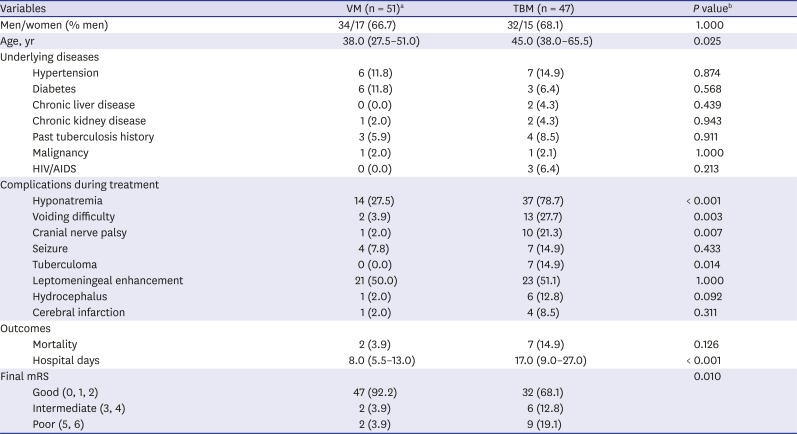


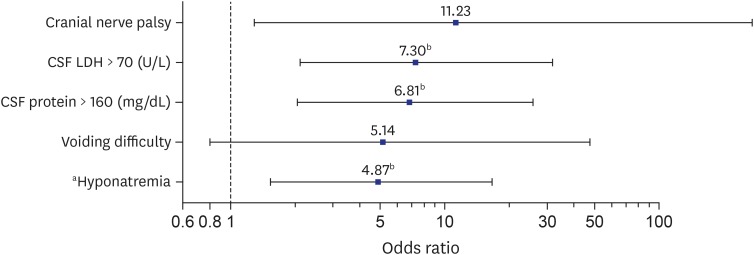

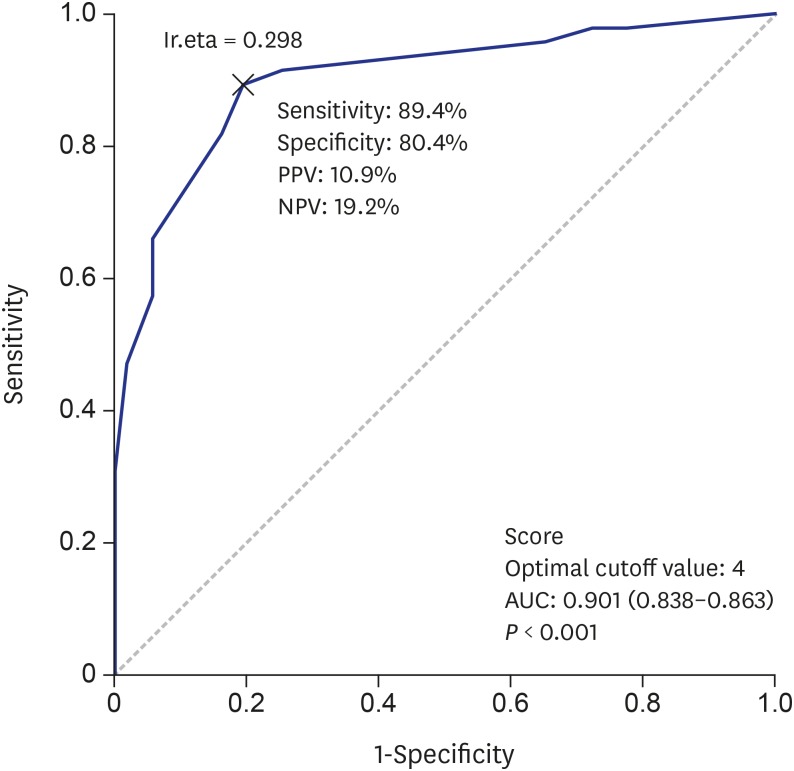
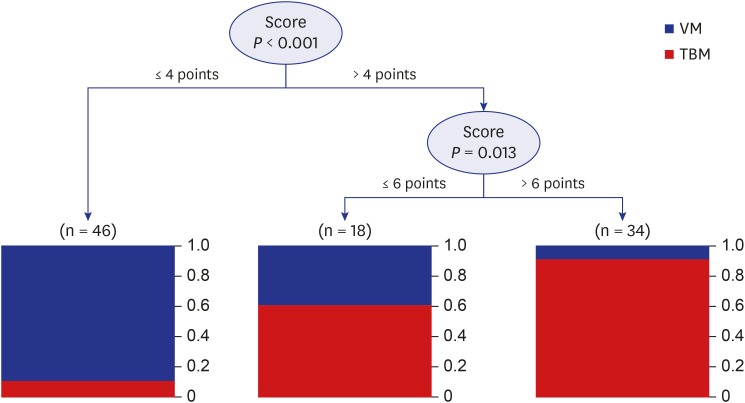





 PDF
PDF Citation
Citation Print
Print



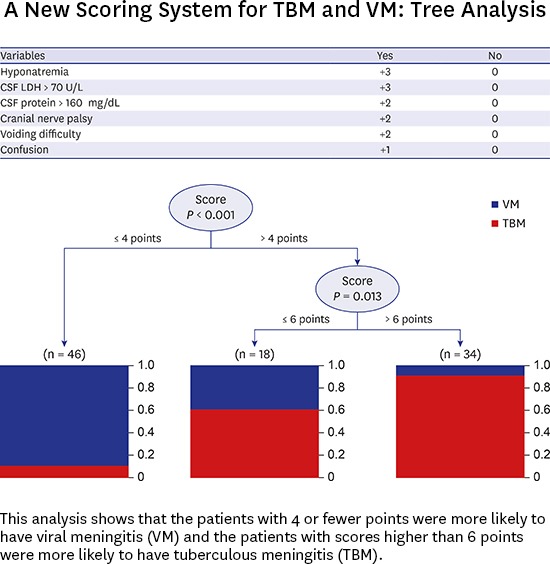
 XML Download
XML Download